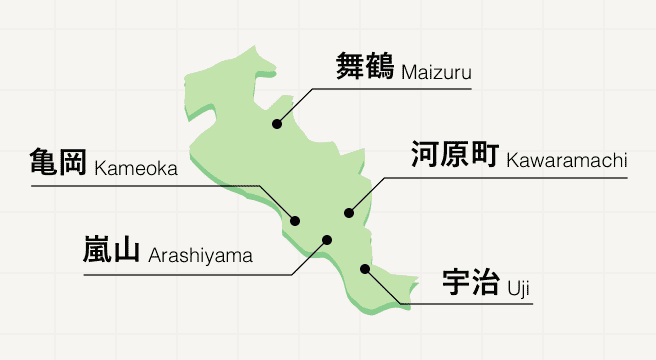Culture / Tour Spots in Around Kiyomizu-Dera Temple Area
Area
-
-
Kyoto
-
-
Kyoto
-
-
Around Kiyomizu-Dera Temple
-
- All areas
- Around Gion
- Around Kiyomizu-Dera Temple
- Around Okazaki
- Around Ginkaku-Ji Temple
- Ichijo-ji Temple / Shugakuin
- Around Fushimi Inari
- Around Kyoto Station
- City Center
- Around Kyoto Imperial Palace
- Around Nishijin
- Around Kamigamo
- Around Kinkaku-Ji Temple
- Uzumasa / Hanazono
- Arashiyama / Sagano / Takao
- Around Mt. Hiei
- Ohara / Kurama / Kifune
- Katsura / Nishiyama
- Yamashina / Daigo
- Around Fushimi
- Around Uji
- Joyo / Yawata
- Kyotanabe / Kizugawa
- Kameoka / Nantan
- Maizuru / Miyazu
-
Around Kiyomizu-Dera Temple

Category


-
- Kyoto National Museum
- Leisure / Hobbies
- Kyoto Kyoutoshi Higashiyama-ku Chayachou 527
- A museum located in the Chaya-cho neighborhood of Higashiyama Ward which first opened in 1897 as the Imperial Museum of Kyoto. The museum changed to its current name in 1952. Visitors can enjoy viewing the museum’s collection of masterpieces and historic objects, including National Treasures, such as paintings, carvings, writings, and swords. The museum also holds special exhibitions.
-
- Ryozen Museum of History
-
4.065 Reviews
- Leisure / Hobbies
- Kyoto Kyoutoshi Higashiyama-ku Seikanjiryousanchou 1
- The museum is located to the southeast of Kodaiji Temple, across from the Kyoto Ryozen Gokoku Shrine. The museum opened in 1970 as Japan's first museum specializing in comprehensive research on the history of the period from the end of the Edo Period (1603-1867) to the Meiji Restoration (around 1868-1889). A large number of relics and other materials belonging to historical figures active in the last days of the Tokugawa shogunate, both on the side of bakufu (the Shogunate) side and tobaku-ha (overthrowing-the-Shogunate group) have been collected and researched. The exhibition is held based on a theme selected from over 5,000 pieces of materials.
-
This isnt a good or bad review. Just a warning to English speakers. On our first attempt to visit, we hiked the long walk uphill from the bus-stop in 34° heat. The museum was closed. We later found...
-
- Kiyomizu Sannenzaka Museum
-
4.041 Reviews
- Leisure / Hobbies
- Kyoto Kyoutoshi Higashiyama-ku Kiyomizu Buddhist temple in front of Shimokita Shimizu 3-337-1
- An art museum dedicated to collecting and displaying primarily cloisonné ware, gold and silver lacquerware, metalwork, earthenware, and carvings from the late Edo, Meiji, and Taisho periods. The owner, enchanted with the artworks of the Meiji period made with such fine technique, came up with the idea of opening a museum after attempting to purchase masterpieces from the period that had ended up overseas. The contents of the museum’s standing exhibits is completely changed out once each year. The Museum also holds special exhibitions every three months.
-
Its not a very big museum, but that just adds to the whole coziness of the place. Exhibits are nicely done in a traditional way.
Kyoto Areas

Its wooden tea houses, shuffling geisha, and spiritual sights have seen Kyoto hailed as the heart of traditional Japan, a world apart from ultramodern Tokyo. Despite being the Japanese capital for over a century, Kyoto escaped destruction during World War II, leaving behind a fascinating history which can be felt at every turn, from the fully gold-plated Kinkakuji Temple down to traditional customs such as geisha performances and tea ceremonies, which are still practiced to this day.
Best of Kyoto
Search by Region
-
- Hokkaido / Tohoku
- Hokkaido
- Aomori
- Iwate
- Miyagi
- Akita
- Yamagata
- Fukushima
-
- Kanto
- Ibaraki
- Tochigi
- Gunma
- Saitama
- Chiba
- Tokyo
- Kanagawa
-
- Koshinetsu / Hokuriku
- Niigata
- Toyama
- Ishikawa
- Fukui
- Yamanashi
- Nagano
-
- Tokai
- Gifu
- Shizuoka
- Aichi
- Mie
-
- Kinki
- Shiga
- Kyoto
- Osaka
- Hyogo
- Nara
- Wakayama
-
- Chugoku
- Tottori
- Shimane
- Okayama
- Hiroshima
- Yamaguchi
-
- Shikoku
- Tokushima
- Kagawa
- Ehime
- Kochi
-
- Kyushu / Okinawa
- Fukuoka
- Saga
- Nagasaki
- Kumamoto
- Oita
- Miyazaki
- Kagoshima
- Okinawa















